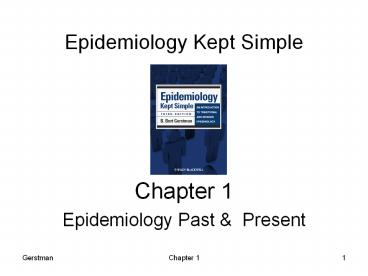Epidemiology Kept Simple - PowerPoint PPT Presentation
Title:
Epidemiology Kept Simple
Description:
Epidemiology Kept Simple Chapter 1 Epidemiology Past & Present Epidemiology Defined Greek roots epi = upon (as in epidermis ) demos = the people (as in ... – PowerPoint PPT presentation
Number of Views:325
Avg rating:3.0/5.0
Title: Epidemiology Kept Simple
1
Epidemiology Kept Simple
- Chapter 1
- Epidemiology Past Present
2
Epidemiology Defined
- Greek roots
- epi upon (as in epidermis)
- demos the people (as in democracy)
- ology to speak of, to study
- Modern definitions of epidemiology refer to
- Distributions of
- Health determinants
- Disease and other health-related outcomes
- Populations
- Application in control of health problems
3
Public Health Defined
- Definition of public health
- organized effort
- Intended to reduce of morbidity mortality and
improve health - Core disciplines public health (CEPH / ASPH)
- Epidemiology
- Biostatistics
- Health administration
- Behavioral sciences
- Environmental health sciences
4
Epi compared to public health
- Epidemiology ? study of
- Public health ? organized effort
Epi the methodological backbone of public
health
5
Health
- There is no single definition of health
- Standard definition ? absence of disease
- WHO definition (1948) ? physical, mental, and
social well-being not merely the absence of
disease - Newer definitions have not yet withstood the test
of time and should be treated with healthy
skepticism
6
Basic Terms
- Morbidity related to disease or disability
- Mortality related to death
- Endemic normal occurrence of a condition
- Epidemic much greater than normal occurrence of
a condition - Pandemic an epidemic on multiple continents
- Incidence rate or risk of developing a
condition - Prevalence proportion of population with a
condition
7
Uses of Epi (Morris 1957)
- Historical study
- Community diagnosis
- Working of health services
- Individual chances
- Completing the clinical picture
- Identify new syndromes
- Search for causes (paramount for prevention)
8
Demographic Transition
? mortality ? fertility ? aging ? change in shape
of popn pyramid
9
Epidemiologic Transition
- shift from acute contagious diseases
- to
- chronic lifestyle diseases
Leading Causes of Death Leading Causes of Death Leading Causes of Death
1900 1990
1 Pneumonia / influenza Heart disease
2 Tuberculosis Neoplasms
3 Diarrhea Cerebrovascular
10
Reasons for Epi.Transition
- During the first half of 20th century
- Improved standard of living
- Vaccination
- Improved nutrition
- Sanitation and vector control
- During the second half of 20th century
- Birth control
- Improvements in lifestyle
- Medical technology (e.g., antibiotics, treatment
of hypertension, improved anesthetic safety)
11
Causes of Death, U.S., 19501990
12
Mortality Trends of Selected Cancers U.S., 1940
- 1995
- Respiratory and prostate increased
- Colorectal stomach declined
- Breast cancer about the same
13
Life Expectancy Trends
- Dramatic increases all groups
- Rank
- White women
- Black women
- White males
- Black men
14
Selected Historical Figures Events
- Hippocrates (400BCE)
- Age of scientific enlightenment (17th 18th
centuries) - John Graunt (1620 1674)
- Pierre Charles Louis (1787 1872)
- John Snow (1813 1858)
- Germ Theory (mid 19th century)
- Modern epidemiology (post WWII)
15
Enlightenment
- The birth of modern medicine and public health
must be studied in the context of the Western
Enlightenment (pp. 1112). - Barzun, J. (2001). From Dawn to Decadence 500
Years of Western Cultural Life New York
HarperCollins.
16
Demographic Approach
17th Century Life Table 17th Century Life Table
Age surviving
6 64
16 40
26 25
36 16
46 10
56 6
60 3
76 1
80 0
John Graunt (162074)
17
Lesson from Graunt (Rothman, 1996)
- Was brief
- Made reasoning clear
- Subjected theories to multiple and varied tests
- Invited criticism
- Willing to change ideas when confronted with
contradictory evidence - Avoided simplistic interpretations of data
18
Germ Theory (Highlights)
- Until the 19th century, germ theory played second
fiddle to vague theories of pollution (e.g.,
miasma theory) - Examples of early contagionists
- Fracastoro (16th century Italian)
- Henle Koch (German physiologists)
- John Snow (epidemiologists hero)
- Pasteur (1865 experimental proof in silkworms)
- Daniel Salmon (vector borne transmission)
19
John Snow, Our Hero
- Snows cholera theory
- Epidemics follow routes of commerce
- Agent is free-living multiplies within the host
- Transmission is water-borne, spread via fecal
contamination, ingested orally - Patho-physiology diarrhea ? fluid loss ?
smudging of blood ? asphyxiation ? death
John Snow (18131858)
20
Snows Methods
- Ecological comparisons compared cholera rates by
region - Cohort comparisons compared cholera rates in
exposed and non-exposed households - Case-control comparisons compared exposure to
contaminated water in cases and non-cases
21
Ecological Comparisons
- Southwark Water Company ? high neighborhoods
rates - Mixed service ? intermediate rates
- Lambeth Water Co. neighborhoods ? no cases
22
Cohort Comparisons
Water Source Cases Homes Rate per 10,000
Southwark 1263 40,046 315
Lambeth 98 26,107 37
Both 1422 256,423 59
Example of calculation Southwark rate 1263 /
40,046 .0315 315 / 10,000
23
Snows mapquasicase-control
24
Snows Quasi Case-Control Analysis
- Cases more likely to be exposed to Broad St. pump
water than non-cases (controls) - Among cases
- 61 used Broad St. water, 6 did not, and 6 were
uncertain - Among controls Broad St. water use was rare
- e.g., at the Brewery (no cases) the men were
allowed a certain quantity of malt liquor, and
do not drink water at all
25
Post-WWII (Modern) Epidemiology
- Epidemiologic transition ? shift in focus from
acute infectious diseases to chronic life style
diseases - Exemplar studies
- The British Doctors Study
- The Framingham Heart Study































